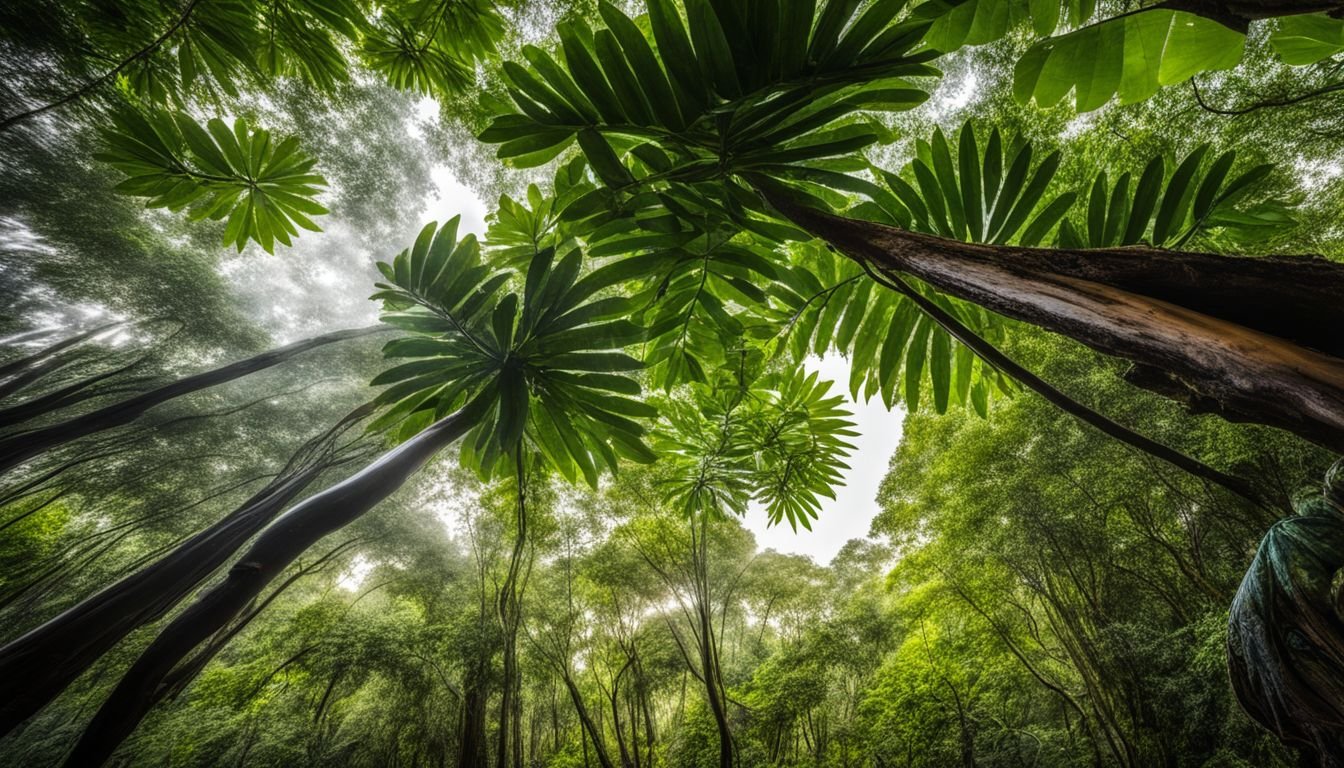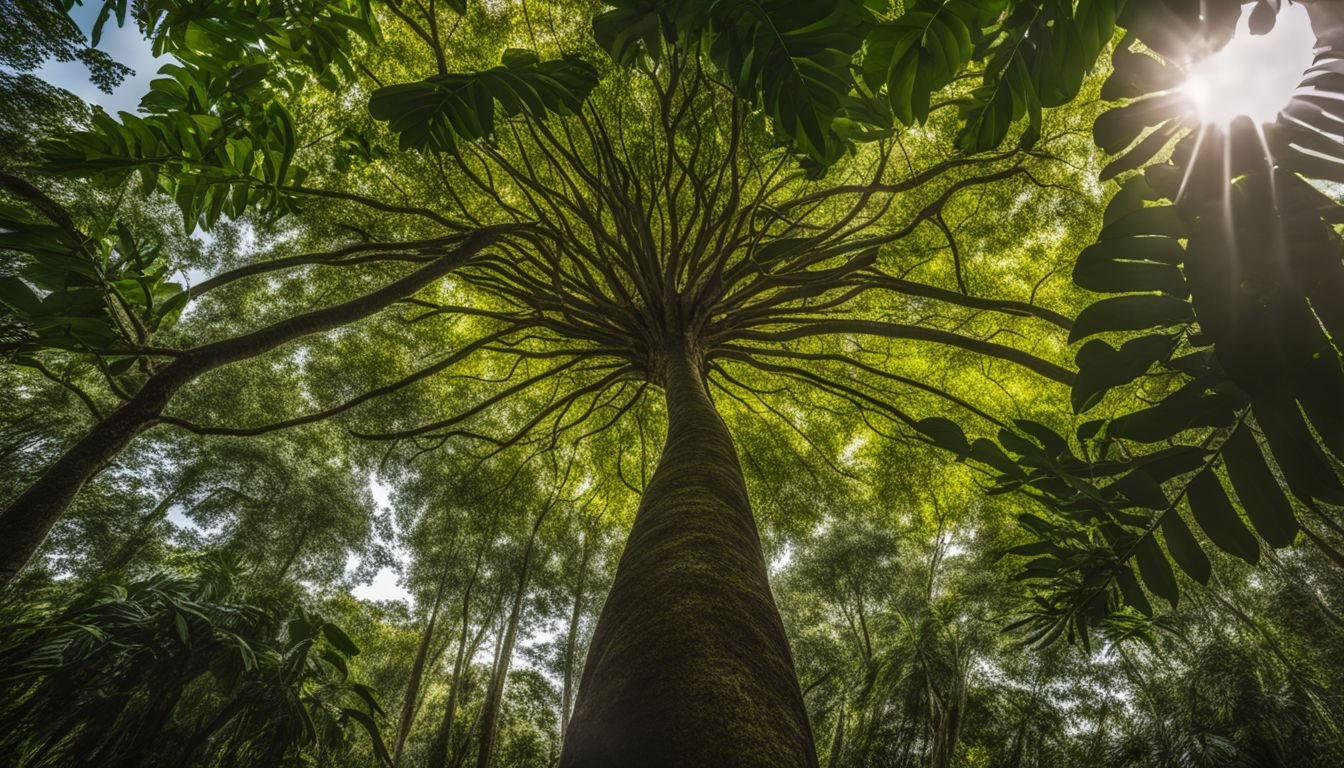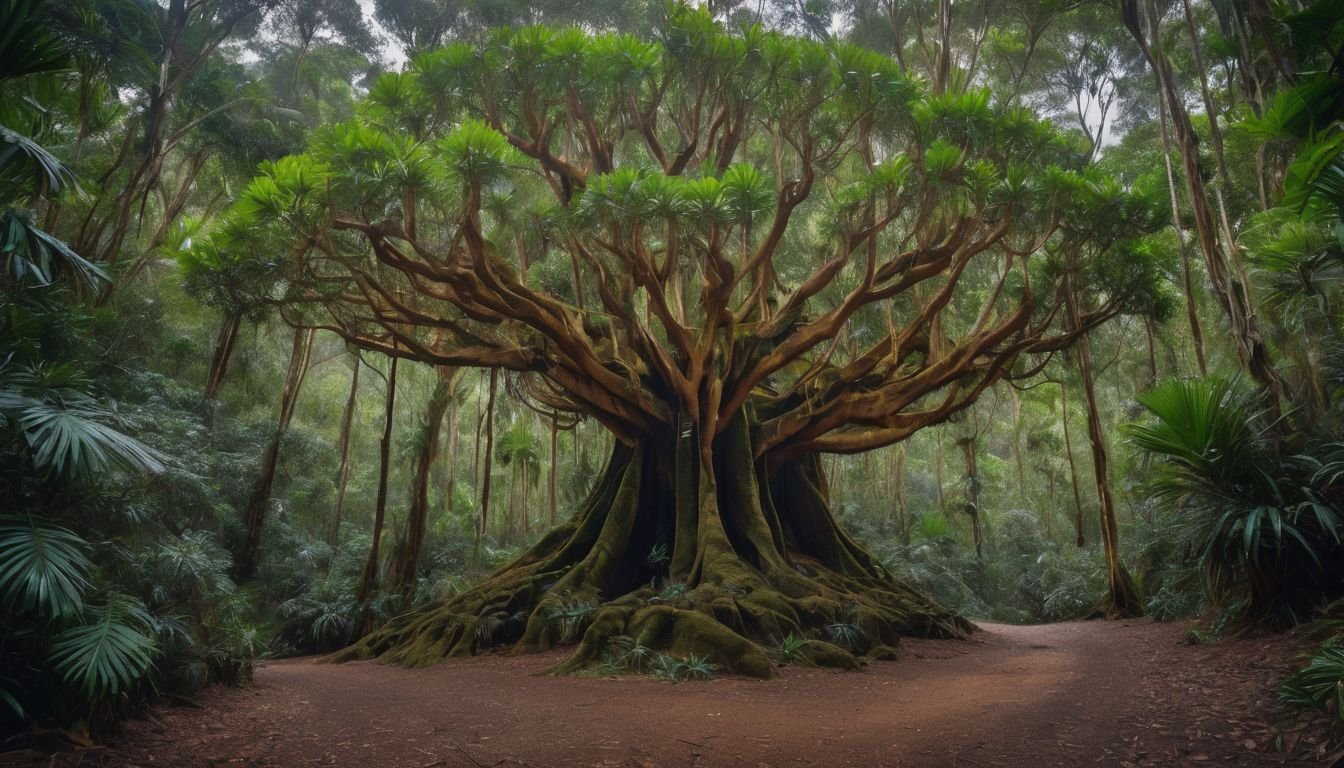Many of us have found ourselves stopping in our tracks, utterly captivated by the sight of the Schefflera actinophylla – or as it’s more commonly known, the Australian Umbrella Tree.
Standing proudly in our rainforests and gallery forests, its lush leaves fanning out like a grand umbrella and those striking red flowers dangling like jewels; it’s not hard to see why it commands such attention.
Yet, beneath its alluring facade lies a complexity that many of us aren’t aware of. It’s true – while this species adds an undeniable charm to our landscapes, it also brings with it challenges that could threaten the delicate balance of our native ecosystems.
And just like you, we’ve been curious about what impact this tree really has on Australia’s natural beauty.
We’re in the same boat here – noticing those areas where rather than playing nice with its surroundings, this plant seems more interested in taking over. Our team has dived into research headfirst to get to the bottom of this phenomenon.
Even though it calls northern and north-eastern Queensland coasts home (not to mention other far-flung locations like New Guinea and Java), there are spots where it simply doesn’t play fair with local flora under certain conditions.
This article is geared towards peeling back those layers: exploring both the allure and challenges presented by the Schefflera actinophylla. From getting up close and personal with its biological make-up to confronting head-on its invasive tendencies, we’re set on offering you a well-rounded guide on how best to manage this intriguing yet contentious species.
Together, let’s uncover ways on how balance can be lovingly restored within our precious ecosystems.
Key Takeaways
- Schefflera Actinophylla, also known as the Australian Umbrella Tree, originally comes from northern and north-eastern Queensland. It grows in rainforests and gallery forests and can reach up to 15m tall.
- This tree has both positive and negative impacts on its environment. Its flowers attract nectar – eating birds, while fruit provides food for various animals. However, it competes aggressively with native plants for resources such as light and nutrients, leading to reduced biodiversity.
- Effective control methods include avoiding cultivation in prone areas, limiting propagation through seeds or cuttings, manually removing young plants before they seed, using herbicides responsibly on mature plants, promoting community awareness programs about its impact, maintaining regular monitoring for new growths after removal efforts are made initially.
- Educating communities about the environmental implications of cultivating Schefflera Actinophylla is essential. By working together towards controlling this species’ spread within vulnerable ecosystems ensures that Australia’s unique natural heritage remains intact for future generations.
- Reporting sightings of Schefflera Actinophylla growing outside cultivated areas is important. This helps authorities manage the plant’s spread more efficiently and protect sensitive environments against invasive species threats.
The Schefflera Actinophylla: An Overview

We often marvel at the unique and striking presence of the Schefflera Actinophylla, also known as the Queensland umbrella tree. This plant, with its glossy compound leaves and towering stature, has roots deeply embedded in Australia’s ecological narrative.
Family and Origin
The Australian Umbrella Tree, scientifically known as Heptapleurum actinophyllum and also referred to by other names like the Queensland umbrella tree or octopus tree, proudly belongs to the Araliaceae family.
This diverse family includes both trees and shrubs that are often recognised for their complex leaf patterns and unique flower structures. Originating from the lush tropical rainforests and gallery forests of northern and north-eastern Queensland coasts, as well as parts of the Northern Territory in Australia, this species has rooted itself deeply into the local ecosystem.
Its journey doesn’t end there; it extends beyond Australian borders to New Guinea and Java, showcasing its adaptability across different landscapes.
Thriving under full sun or in closed forests, our Schefflera Actinophylla exhibits a remarkable ability to grow up to 15m (50 feet) tall. The structure is quite captivating with palmately compound leaves grouped into seven glossy leaflets each, portraying a canopy that resembles an umbrella – hence its popular name.
Initially growing as a hemiepiphyte on other rainforest trees illustrates not just its survival instinct but also its integral part in our rich biodiversity. Our gardens might fancy hosting such an exotic plant for its striking appearance; however, understanding its roots helps us appreciate more than just its beauty but also its role within the ecological tapestry of our home grounds.
Characteristics
Moving from its intriguing background to the distinctive features, Schefflera Actinophylla showcases characteristics that capture our attention and demonstrate why it stands out in Australia’s landscapes.
This tree, reaching heights of up to 15m, flourishes with palmately compound medium green leaves. Each grouping boasts seven leaflets, painting a lush picture against forest backdrops.
Its reproductive prowess is just as remarkable, producing racemes extending up to 2m long filled with small red flowers. Up to 1,000 flowers can bloom on these branches, creating an abundant source of nectar that draws in nectar-eating birds for pollination.
Following flowering, the fruits become a vital food source for various animals including musky rat-kangaroos and spectacled flying foxes—a true testament to its ecological role.
We also find that its leaves serve as a crucial diet component for Bennett’s tree-kangaroo among others. Its adaptability allows it not only to grow as a stunning decorative piece in gardens but also highlights how it integrates into broader ecosystems through relationships with local wildlife.
This duality underscores both its beauty and potential challenges when managing its spread outside native habitats.
Common Names
Diving deeper into the identity of Schefflera Actinophylla, it’s fascinating to learn about its array of common names. People often call it the Australian Umbrella Tree, pointing to its origin and umbrella-like leaf arrangement.
Another name you might hear is the Queensland Umbrella Tree, which highlights its prevalence in south-eastern Queensland. The term Octopus Tree comes from its unique branched flower clusters that spread out like an octopus’s arms.
Lastly, Amate is a name used by some garden enthusiasts, showcasing the plant’s versatility in both outdoor and indoor settings.
Understanding these names not only enriches our knowledge but also connects us to a global community of gardening aficionados who appreciate the ecological significance and beauty of this species.
Each name tells a story of local culture, characteristics, or simply how people have come to view this remarkable tree through various lenses around the world. It helps us in identifying and discussing invasive species like the Schefflera Actinophylla with fellow Australians concerned about preserving our native ecosystems while enjoying their gardening pursuits.
The Schefflera Actinophylla in its Natural Habitat

Schefflera Actinophylla thrives in the lush landscapes of Australia’s rainforests and gallery forests. It spreads its broad leaves and tall stature, becoming a dominant presence where it grows.
Growth and Development
We often marvel at how the Schefflera Actinophylla reaches up to 15m tall, demonstrating a vigorous growth pattern that stands out in Australia’s diverse ecosystems. This species doesn’t just grow; it thrives by attaching itself as a hemiepiphyte on other rainforest trees, showcasing its adaptability and resilience.
Its palmately compound medium green leaves spread wide, capturing every bit of sunlight to fuel its ascent towards the forest canopy.
The tree’s growth doesn’t stop with its impressive height; it also produces racemes stretching up to 2m long, adorned with as many as 1,000 small red flowers. This prolific blooming is not only a spectacle for the eyes but also plays a critical role in the local ecosystem by attracting a variety of pollinators.
Through this interaction, the Schefflera Actinophylla ensures its continued proliferation across open woodlands and gallery forests.
As we explore further into how this plant impacts our cherished rainforests and gallery forests, let’s keep in mind these remarkable growth characteristics that contribute to both its beauty and environmental challenges.
Location and Distribution
As the Schefflera Actinophylla thrives in its growth stage, its spread across certain regions becomes apparent. This plant calls the tropical rainforests and gallery forests of northern and north-eastern Queensland coasts as well as the Northern Territory home.
It also extends its reach to New Guinea and Java, showcasing a broad distribution that aligns with its preference for warm, humid climates.
In Australia, particularly within these preferred habitats, the Schefflera Actinophylla has established itself not just as a local native but also as a notable presence. Its ability to grow up to 15 meters tall allows it to stand out amongst other flora.
For us who love Australian plants and gardening, understanding this tree’s footprint can help gauge both its beauty and impact on our ecosystems.
The adaptability of this species means it doesn’t limit itself strictly to wild settings; it has found a place in domestic cultivation too. Especially in temperate regions where indoor planting is common, maintaining a minimum temperature of 13°C ensures their survival indoors.
Across urban landscapes or within controlled environments like botanical gardens – including the Australian National Botanic Gardens – the Schefflera Actinophylla signifies man’s attempt at taming nature’s splendor for closer appreciation.
Impact of the Schefflera Actinophylla on Australia’s Rainforests and Gallery Forests
The Schefflera Actinophylla, commonly known as the Australian Ivy Palm, poses a significant threat to Australia’s diverse rainforests and gallery forests. Its rapid growth and aggressive spread choke out native plants, disrupting ecosystems and reducing biodiversity.
Environmental Impact
We face a challenging issue with the environmental impact of Schefflera Actinophylla, especially in Australia’s rainforests and gallery forests. This invasive plant competes aggressively with native species for resources such as light, water, and soil nutrients.
Its rapid growth allows it to overshadow smaller plants and saplings, reducing biodiversity in the process. Additionally, as it spreads, this environmental weed can disrupt the natural balance of the ecosystem by altering habitat structures essential for wildlife.
Control methods including mechanical removal and targeted herbicide applications are vital in managing its spread. Our collective efforts in weed management help preserve our unique landscape and the diverse life it supports.
Engaging in informed gardening practices ensures we contribute positively to our environment while enjoying its beauty safely.
Impact on Native Species
Schefflera Actinophylla serves as a source of food and habitat for various wildlife in Australia’s rainforests and gallery forests. Its flowers attract nectar-eating birds, while the berries provide nourishment to many bird species and animals.
This interaction highlights the tree’s critical role within these ecosystems, supporting biodiversity by offering essential resources for survival.
However, despite its benefits, this tree can also pose challenges as an environmental weed in certain areas. Its rapid growth and prolific seeding enable it to potentially outcompete native plant species for space, light, and nutrients.
This competition can lead to a decrease in native flora diversity, altering habitat structures vital for some animal populations. Such changes affect not only the plant life but also the broader ecosystem balance.
Control methods including physical removal and chemical treatments are often necessary to manage Schefflera Actinophylla’s spread in sensitive areas. Gardeners and conservationists work together towards preserving Australia’s unique biodiversity by actively participating in controlling invasive species like the dwarf umbrella tree (Schefflera arboricola).
These efforts ensure that native plants have space to grow, maintaining healthy habitats for all forest dwellers.
Control Methods for Schefflera Actinophylla
We understand the importance of maintaining Australia’s unique biodiversity and the role we all play in weed control. Here, we share some effective strategies to manage Schefflera actinophylla, an environmental weed that poses a threat to our rainforests and gallery forests.
- Prevent Cultivation in Vulnerable Areas: We can reduce the spread of this invasive species by avoiding its cultivation in regions identified as prone to invasion, including parts of Queensland and New South Wales. Given its invasive nature in similar climates like Florida and Hawaii, it’s crucial we take this step seriously.
- Control Propagation: Limiting propagation through seed or cuttings plays a pivotal role in controlling its spread. Since Schefflera actinophylla seeds are primarily dispersed by birds, securing trash and compost bins can prevent birds from accessing seeds that might sprout in unwanted areas.
- Manual Removal for Young Plants: Young plants with shallow roots can be manually removed. This method is most effective before the plant has set seeds. Wearing gloves and using appropriate tools can make this task easier and prevent skin irritation from the plant’s sap.
- Herbicide Application on Mature Plants: For larger, established plants, carefully applied herbicides might be necessary. Choose herbicides approved for use in environmental weeds by local agriculture or herbaria authorities to ensure they won’t harm native species.
- Community Awareness Programs: Educating communities about the impact of Schefflera actinophylla on Australia’s ecosystems encourages collective action. Workshops and informational brochures can inform residents about identification, removal techniques, and alternative local plants for gardening.
- Regular Monitoring and Maintenance: After initial removal efforts, regular checks are essential to catch any new growth early. Establishing a routine monitoring program within local communities can help manage regrowth effectively.
- Report Sightings: If you spot Schefflera actinophylla growing outside cultivated areas, report it to local weed control authorities or environmental agencies like those on Christmas Island or Lord Howe Island where vigilance against environmental weeds is critical for ecosystem health.
Conclusion
Schefflera Actinophylla, while striking in appearance, poses a significant threat to Australia’s unique ecosystems. Its rapid spread outcompetes native flora, disrupting habitats for countless wildlife species.
Eradicating this invasive becomes crucial to protecting our rainforests and gallery forests. Through collective efforts and informed action, we can curb its impact. Safeguarding our natural heritage requires vigilance and proactive measures against such intruders.
FAQs
1. What is Schefflera Actinophylla?
Schefflera Actinophylla, also known as Brassaia actinophylla, is a type of plant with shiny, glabrous leaves and umbrella-like clusters of flowers. It thrives in Australia’s rainforests and gallery forests.
2. How does Schefflera Actinophylla impact the environment in Australia?
This plant can dominate native vegetation due to its rapid growth and large size, impacting local ecosystems by limiting the growth of native plants and altering animal habitats.
3. Why should Australians be concerned about Schefflera Actinophylla’s spread?
Its ability to outcompete native flora disrupts the balance of ecosystems, posing a threat to biodiversity in rainforests and gallery forests across Australia.
4. Can anything be done to control Schefflera Actinophylla’s environmental impact?
Efforts can include monitoring its spread closely, removing it from critical areas where it threatens native species, and educating the public on avoiding planting or encouraging its growth.
